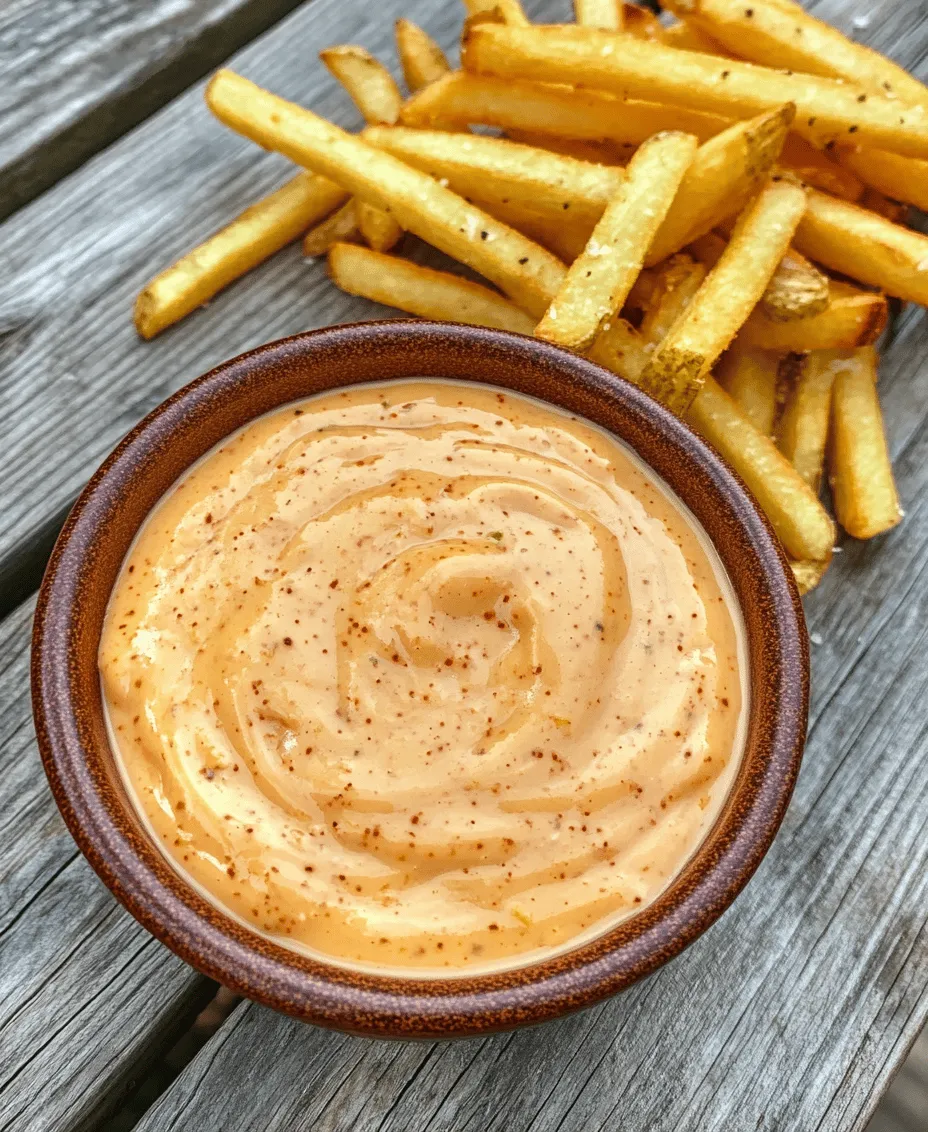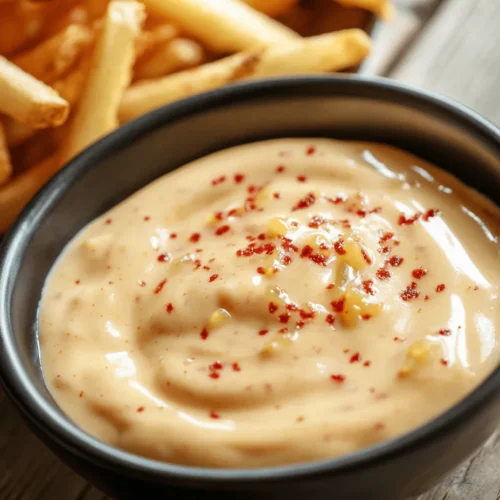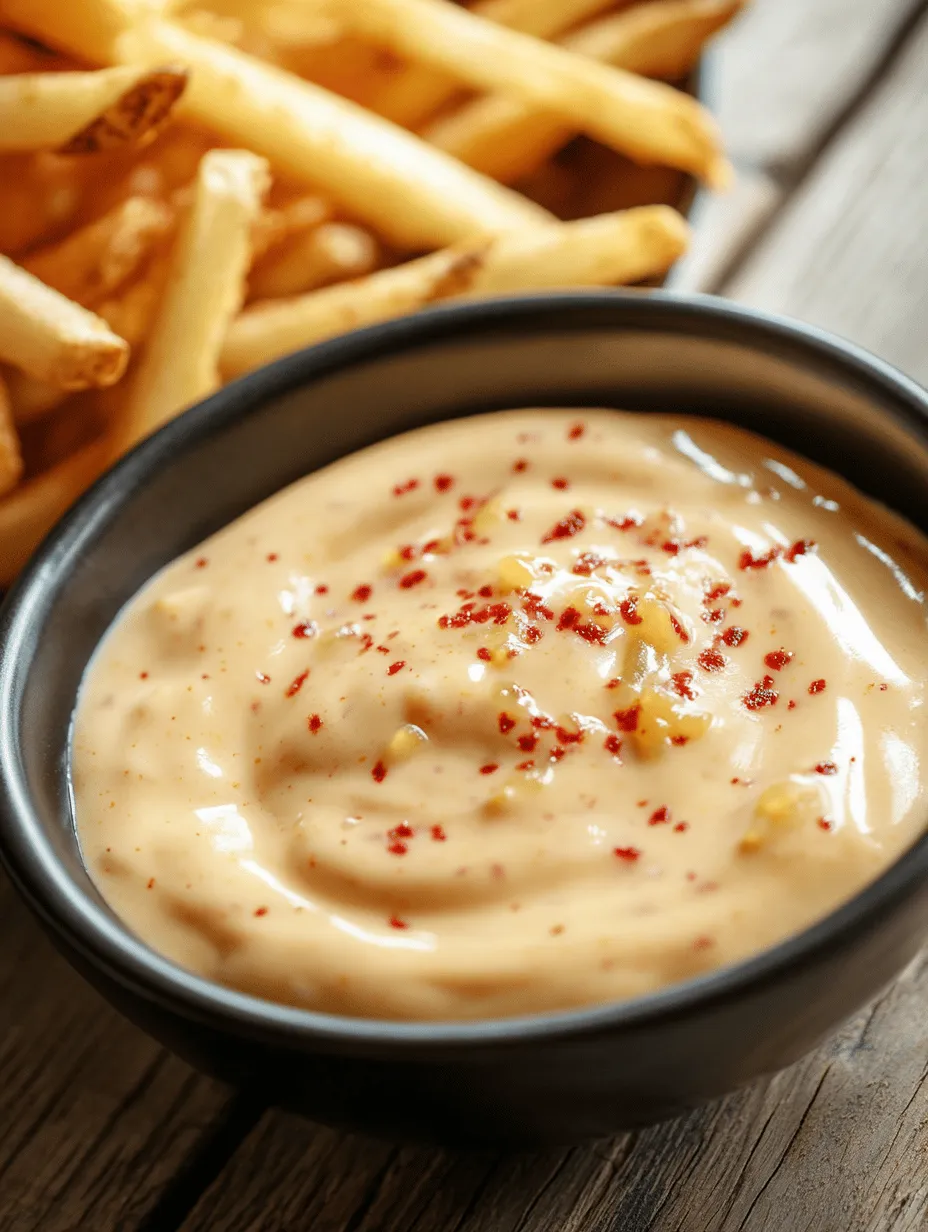Introduction
Fry sauce, a cherished condiment that graces tables across various cultures, has become synonymous with the perfect pairing for fries, burgers, and more. Its creamy texture and delightful flavor make it a beloved choice for both casual diners and gourmet restaurants. While many of us have enjoyed fry sauce in fast-food joints or trendy eateries, the magic of this condiment truly shines when it’s made at home. Crafting your own fry sauce allows for complete control over the flavor profile, catering to individual preferences and dietary needs.
In this article, we will delve into the “Legendary Fry Sauce” recipe, a simple yet versatile condiment that can elevate any meal. Whether you’re hosting a barbecue, enjoying a movie night, or simply looking for a delicious way to enhance your fries, this fry sauce is a must-try. With just a handful of common ingredients, you can whip up a creamy delight that will have your taste buds singing. Let’s explore the background of fry sauce, its varied interpretations, and how to prepare this legendary recipe step-by-step.
Understanding Fry Sauce
History of Fry Sauce
The exact origins of fry sauce remain a topic of debate, with various claims to its creation. Many food historians trace its roots back to the 1940s in the United States, specifically to the state of Utah, where it was served in local diners alongside fries. Some argue that fry sauce is a unique American invention, while others point to its similarities with other sauces around the world, suggesting it has deeper international influences.
In the mid-20th century, fry sauce gained popularity beyond Utah, especially among fast-food chains. It became a staple condiment for French fries, burgers, and chicken nuggets, prompting many families to recreate it at home. The sauce’s creamy consistency and balanced flavor profile made it a hit with both kids and adults alike, and its presence in American culture solidified over the years.
Variations Around the World
Fry sauce is not limited to one specific recipe; it has a multitude of interpretations around the globe. Each region tends to incorporate local ingredients and culinary preferences, resulting in a rich tapestry of flavors.
– In the Netherlands, fry sauce, known as “fritessaus,” often has a slightly tangier taste and is thicker than the typical American version. It’s commonly served with fries, known as “patat.”
– In Canada, some regions favor a variation called “burger sauce,” which includes additional spices and flavors, making it a go-to for burgers as well.
– In the Middle East, variations of fry sauce incorporate tahini or yogurt, adding a unique twist that reflects regional ingredients.
– In Latin America, you may find fry sauces that include spices such as cumin or chili powder, lending a kick to the traditional flavor.
Each of these variations highlights the adaptability of fry sauce, showcasing how cultures can interpret the same basic idea in diverse ways.
The Rise of Fry Sauce in Contemporary Cuisine
In recent years, fry sauce has seen a resurgence in popularity, not only in home kitchens but also on restaurant menus. Chefs and home cooks alike are experimenting with flavors and ingredients, taking this simple condiment to new heights. Gourmet versions featuring infused oils, artisanal mustards, or even exotic spices are becoming commonplace, showcasing the versatility of fry sauce as a canvas for culinary creativity.
Social media platforms have also played a significant role in the fry sauce revival. Food bloggers and influencers share their own takes on the classic recipe, sparking interest and inspiring others to create their versions. The hashtag #frysauce has gained traction, with countless photos and videos showcasing the sauce’s delightful appearance and the myriad of dishes it complements.
Ingredients Breakdown
Creating the “Legendary Fry Sauce” is a straightforward process, but understanding each ingredient’s role is essential to achieving the perfect balance of flavors. Here’s a breakdown of the main components that make this sauce a standout:
– Mayonnaise: The creamy base of fry sauce, mayonnaise adds a rich, velvety texture that forms the foundation of the condiment. It provides a neutral flavor that allows other ingredients to shine without overwhelming the palate.
– Ketchup: This beloved pantry staple brings sweetness and acidity to the fry sauce. The tomato flavor complements the richness of mayonnaise, creating a balanced and harmonious taste.
– Apple Cider Vinegar: A splash of apple cider vinegar enhances the sauce’s tanginess, cutting through the creaminess and providing a refreshing contrast. It also helps to brighten the overall flavor profile.
– Dijon Mustard: This ingredient introduces a subtle kick, adding a layer of complexity to the sauce. The slight heat from Dijon mustard elevates the flavor and makes the sauce more interesting.
– Sweet Pickle Relish: Adding a touch of sweetness and crunch, sweet pickle relish contributes texture and flavor, making the fry sauce more dynamic.
– Garlic Powder and Onion Powder: These aromatic seasonings infuse depth into the sauce, enhancing its overall taste. They provide a savory note that complements the other ingredients beautifully.
– Salt and Pepper: Essential seasonings, salt and pepper, enhance the flavors of all the ingredients, ensuring that the fry sauce is well-balanced and satisfying.
– Optional Hot Sauce: For those who enjoy a little heat, adding a few dashes of hot sauce allows for customization. This simple addition can transform the fry sauce into a spicy delight, perfect for those who crave a kick.
Understanding the role of each ingredient not only helps in making the fry sauce but also empowers you to customize it according to your taste preferences.
Step-by-Step Preparation
Now that you have a good understanding of fry sauce and its ingredients, let’s dive into the preparation process. Making the “Legendary Fry Sauce” is a breeze, and with just a few simple steps, you’ll have a delicious condiment ready to elevate your meals.
Step 1: Combining Mayonnaise and Ketchup
Begin by measuring out equal parts of mayonnaise and ketchup. This combination serves as the creamy base of your fry sauce. In a medium-sized mixing bowl, add the mayonnaise first, followed by the ketchup. Using a whisk or a spatula, gently mix these two ingredients together until they are fully blended and smooth. The result should be a creamy pinkish sauce that sets the stage for the additional flavors to come.
Step 2: Adding the Vinegar, Mustard, and Relish
Next, incorporate the apple cider vinegar, Dijon mustard, and sweet pickle relish into the bowl. Start by adding one tablespoon of apple cider vinegar, followed by one to two teaspoons of Dijon mustard, depending on your preference for heat. Then, add two tablespoons of sweet pickle relish. These ingredients bring complexity to the fry sauce and are essential for achieving that legendary flavor.
Stir the mixture thoroughly to ensure that all ingredients are evenly incorporated. The tang from the vinegar, the kick from the mustard, and the sweetness from the relish will create a well-rounded taste that will make your fry sauce irresistible.
Step 3: Incorporating Garlic and Onion Powders
The next step is to enhance the sauce’s flavor further by adding garlic powder and onion powder. Start with half a teaspoon of each. These seasonings are crucial for adding depth and richness to the fry sauce. Stir the mixture again, ensuring that the powders are well distributed throughout the sauce.
Step 4: Adjusting Seasoning with Salt, Pepper, and Optional Hot Sauce
Finally, taste the fry sauce and adjust the seasoning as needed. Add salt and pepper to enhance the overall flavor, starting with a pinch of each. If you like a bit of heat, this is the perfect time to add a few dashes of hot sauce. Remember, you can always add more, so start small and adjust according to your preference.
Step 5: Importance of Refrigeration
Once your fry sauce is mixed to perfection, transfer it to an airtight container and refrigerate for at least 30 minutes. This resting period is crucial as it allows the flavors to meld and develop, resulting in a richer and more cohesive taste. The sauce can be stored in the refrigerator for up to two weeks, making it a convenient addition to your meal prep.
By following these steps, you’ll create a legendary fry sauce that is not only delicious but also customizable to suit your taste. Whether you’re enjoying it with fries, burgers, or even as a dip for fresh veggies, this fry sauce will quickly become a staple in your kitchen.

Best Dishes to Pair with Fry Sauce
Fry sauce is not just a condiment; it’s a culinary companion that elevates various dishes. Here are some of the best pairings that highlight the versatility of fry sauce:
French Fries
The classic pairing of fry sauce and French fries is iconic for a reason. The creamy, tangy flavor of fry sauce perfectly complements the salty, crispy texture of freshly fried potatoes. Whether you prefer thin-cut fries, waffle fries, or steak fries, fry sauce enhances the experience, making each bite more enjoyable. For the ultimate indulgence, consider tossing your fries in the fryer for an extra crunch before dipping them into the fry sauce.
Burgers
Enhancing the flavor profile of burgers is another fantastic use for fry sauce. Spread a generous amount on the bun before adding your favorite patty, cheese, and toppings. The creamy texture and zesty flavor of fry sauce work harmoniously with the savory elements of the burger, creating a delightful explosion of flavors with every bite. Consider using it as a secret sauce in place of traditional mayo or ketchup for a tasty twist.
Vegetable Sticks
For those looking for a healthier snacking option, fry sauce can serve as a delicious dip for vegetable sticks. Carrots, celery, cucumbers, and bell peppers are all excellent choices that can be dipped into fry sauce for an extra burst of flavor, making it easier to enjoy your daily servings of veggies. This pairing is not only nutritious but also adds a fun element to your snack time.
Other Potential Uses
Fry sauce isn’t limited to just fries and burgers. Its versatility allows it to shine in various other applications. Use it as a sandwich spread to add creaminess and zest to your favorite deli meats. It can also double as a salad dressing or drizzle over roasted vegetables for an added layer of flavor. The possibilities are endless when it comes to incorporating fry sauce into your meals.
Storage and Shelf Life
To maintain the freshness and flavor of your homemade fry sauce, proper storage is essential.
Best Practices for Storing Fry Sauce
Store fry sauce in airtight containers to preserve its taste and texture. Glass jars or plastic containers with tight-fitting lids are ideal. Avoid using containers that have previously held strong-smelling foods, as they can impart unwanted flavors.
Recommended Containers for Freshness
Mason jars are an excellent choice, not only for their airtight seal but also for their ability to showcase the vibrant color of your fry sauce. Alternatively, BPA-free plastic containers are lightweight and practical for refrigeration. Label your containers with the date of preparation to keep track of freshness.
How Long It Can Be Stored in the Refrigerator
Homemade fry sauce can generally be stored in the refrigerator for up to two weeks. After this period, the flavors may begin to fade, and the sauce may not taste as fresh. It’s always a good idea to taste the sauce before use, especially if it has been stored for several days.
Signs of Spoilage: Ensuring Food Safety
To ensure food safety, always check for signs of spoilage before consuming leftover fry sauce. If you notice any changes in color, texture, or smell, it’s best to discard it. Additionally, if the sauce develops any mold or separation, it should not be consumed.
Nutritional Information
Understanding the nutritional aspects of fry sauce can help you make informed choices about its incorporation into your meals.
Overview of the Nutritional Aspects of Fry Sauce
A typical serving of fry sauce (about two tablespoons) contains approximately 100 calories. The nutritional breakdown will vary based on the specific ingredients you use, particularly if you modify the recipe with healthier alternatives.
Breakdown of Key Nutrients from the Ingredients
The primary components of fry sauce include mayonnaise, ketchup, and various seasonings. Here’s a brief overview of the nutrients you can expect from a standard recipe:
– Calories: About 100 per serving
– Fat: 10 grams (primarily from mayonnaise)
– Carbohydrates: 3 grams (mostly from ketchup)
– Protein: 0 grams
– Sodium: 200-300 mg (varies based on added salt)
Comparison with Store-Bought Alternatives: Health Benefits of Homemade Fry Sauce
One significant advantage of homemade fry sauce is the control over ingredients. Store-bought versions can often contain preservatives, high fructose corn syrup, and excessive sodium. By making your own, you can tailor the recipe to fit dietary preferences and reduce unwanted additives, offering a healthier alternative without sacrificing flavor.
Creative Variations and Flavor Enhancements
If you’re looking to take your fry sauce to the next level, consider experimenting with different flavor profiles.
Exploring Different Flavor Profiles
One of the joys of creating your own fry sauce is the ability to customize it to your liking. Here are some fun ideas to get you started:
– Adding Herbs: Fresh herbs like dill or parsley can bring a refreshing twist to your fry sauce. Simply chop a tablespoon or two and mix it in for added color and flavor.
– Experimenting with Spices: Give your fry sauce a kick by incorporating spices such as smoked paprika or cayenne pepper. These spices can add depth and complexity to the flavor profile, making your fry sauce stand out.
– Incorporating Other Condiments: Mix in other condiments like BBQ sauce for a smoky undertone, sriracha for heat, or honey mustard for a touch of sweetness. Each addition can transform your fry sauce into a unique creation that complements various dishes.
Cultural Adaptations
Fry sauce has transcended borders, and different cultures have put their unique spin on this beloved condiment.
American Variations vs. International Twists
In the United States, fry sauce is often associated with fast food and casual dining. However, international variations abound. In Canada, for instance, fry sauce is commonly served alongside poutine, combining the flavors of gravy and cheese curds with the fry sauce for a rich and satisfying experience.
Local Ingredients That Can Be Integrated for Unique Regional Flavors
Consider incorporating local ingredients to give your fry sauce a regional twist. For example, in Mexico, you might add a hint of lime and cilantro for a zesty version, while in the Mediterranean, a dash of olive oil and garlic could provide a savory depth. Each culture’s approach to fry sauce reflects its culinary traditions, making it a fascinating subject to explore.
Conclusion
The Legendary Fry Sauce is more than just a condiment; it’s a celebration of flavor that enhances meals and gatherings across the globe. Its versatility makes it a must-have in any kitchen, whether you’re enjoying classic fries, juicy burgers, or healthy vegetable sticks. As you experiment with this recipe, don’t hesitate to customize it to suit your taste preferences.
Creating homemade condiments like fry sauce not only elevates your dining experience but also allows you to connect with the joy of cooking. So, gather your ingredients, unleash your creativity, and enjoy the delightful journey of making your very own Legendary Fry Sauce.



